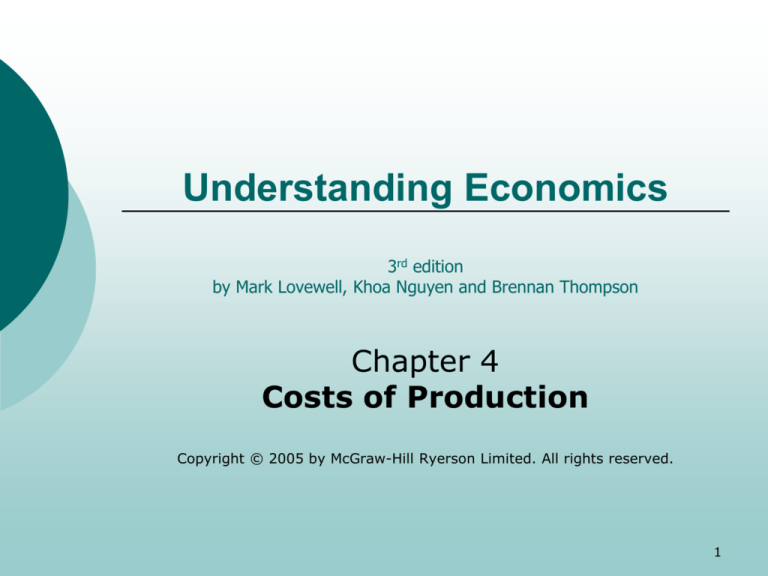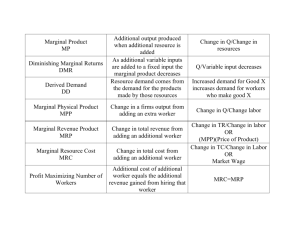
Understanding Economics
3rd edition
by Mark Lovewell, Khoa Nguyen and Brennan Thompson
Chapter 4
Costs of Production
Copyright © 2005 by McGraw-Hill Ryerson Limited. All rights reserved.
1
Learning Objectives
In this chapter you will:
1.
2.
3.
4.
learn about economic costs (explicit and
implicit) of production and economic profit
analyze short-run (total, average, and
marginal) products, and the law of
diminishing marginal returns
derive short-run (total, average, and
marginal) costs
examine long-run results of production
(increasing returns to scale, constant to scale,
and decreasing to scale) and long-run costs
Copyright © 2005 by McGraw-Hill Ryerson Limited. All rights reserved.
2
T 2, Production in the Short Run (a)
In the short run
•
some inputs (such as capital) are fixed
•
other inputs (such as labour) are variable
Inputs are combined to make a business’s
total product
•
Total product: the overall quantity of
output produced with a given workforce
•
average product is total product divided
by the number of workers
•
marginal product is the extra total
product with an additional worker
Copyright © 2005 by McGraw-Hill Ryerson Limited. All rights reserved.
3
Average product = total product (q)
number of workers (L)
Marginal product
= change in total product (Δ q)
change in workforce (Δ L)
Copyright © 2005 by McGraw-Hill Ryerson Limited. All rights reserved.
4
Total chairs
made
1st person
3 chairs
2nd person
7 chairs
3rd person
12 chairs
Average
Product
Marginal
Product
Total
Product
One reason that the marginal product increases can be that teamwork fosters
productivity. Also, with more people, delegation of tasks is possible, leading to an
increase in productivity.
What happens if you have a group of 20 students all working on the same project.
Do you think that the productivity will increase, decrease or will be the same?
Copyright © 2005 by McGraw-Hill Ryerson Limited. All rights reserved.
5
Total chairs
made
Average
Product
Marginal
Product
Total
Product
1st person
3 chairs
3
3
3
2nd person
7 chairs
3.5
4
7
3rd person
12 chairs
4
5
12
One reason that the marginal product increases can be that teamwork fosters
productivity. Also, with more people, delegation of tasks is possible, leading to an
increase in productivity.
What happens if you have a group of 20 students all working on the same project.
Do you think that the productivity will increase, decrease or will be the same?
Copyright © 2005 by McGraw-Hill Ryerson Limited. All rights reserved.
6
The Law of Diminishing Marginal
Returns
Short-run production is determined
by the law of diminishing marginal
returns
the law of diminishing marginal returns:
•
At some point, as more units of a variable
input are added to a fixed input, the marginal
product will start to decrease
average product also falls after some
point
Copyright © 2005 by McGraw-Hill Ryerson Limited. All rights reserved.
7
Relationship between marginal
product and average product
Marginal
Test 1
Test 2
Test 3
80marks
90marks
80marks
Test 1
Test 2
Test 3
80marks
90marks
85marks
Test 1
Test 2
Test 3
80 marks
90marks
88marks
Average
Marginal
Average
Marginal
Average
Copyright © 2005 by McGraw-Hill Ryerson Limited. All rights reserved.
8
Relationship between marginal
product and average product
Test 1
Test 2
Test 3
Marginal
80marks
90marks
80marks
Average
80
85
83.333
Test 1
Test 2
Test 3
Marginal
80marks
90marks
85marks
Average
80
85
85
Test 1
Test 2
Test 3
Marginal
80 marks
90marks
88marks
Average
80
85
86
Copyright © 2005 by McGraw-Hill Ryerson Limited. All rights reserved.
9
Focusing on the test 3 column, why do you
see the average differ in all three cases?
What seems to be the relationship between
the marginal mark and the average mark?
(Refer to Excel)
Copyright © 2005 by McGraw-Hill Ryerson Limited. All rights reserved.
10
Relating Average and Marginal
Values
Average and marginal values are
related using three rules
•
•
•
if an average value rises then the
marginal value must be above the
average value
if an average value falls then the
marginal value must be below the
average value
if an average value stays constant then
the marginal value must equal the
average value
Copyright © 2005 by McGraw-Hill Ryerson Limited. All rights reserved.
11
Total, Marginal, and Average Products
Total
Product
(q)
(workers (T-shirts
per day) per day)
0
0
1
80
2
200
3
250
4
270
5
280
6
270
Marginal
Product
(Δq/ΔL)
(T-shirts
per day)
80
120
50
20
10
-10
Average
Product
(q/L)
(T-shirts
per day)
80
100
83.3
67.5
56
45
300
250
TP
200
150
100
50
0
--
1
2
3
4
5
6
Number of Workers Employed per Day
T-Shirts Produced per Day
Labour
(L)
T-Shirts Produced per Day
Figure 4.2, Page 89 and Figure 4.3, Page 91
Diminishing
returns set in
120
100
80
60
AP
40
20
0
-20
1
2
3
4
5
6
MP
Number of Workers Employed per Day
Copyright © 2005 by McGraw-Hill Ryerson Limited. All rights reserved.
12
Whether the marginal product curve
is itself sloping upward or downward
is irrelevant
If an additional worker is to raise the
average product of all workers, that
additional worker's output must be
greater than the average output of all
the other workers.
Copyright © 2005 by McGraw-Hill Ryerson Limited. All rights reserved.
13
It is immaterial whether the new
worker's contribution to output is
greater or less than the contribution
of the previous worker hired
immediately before; all that matters
it that the new worker's contribution
to output exceeds the average output
of all workers hired previously
Copyright © 2005 by McGraw-Hill Ryerson Limited. All rights reserved.
14
As we can
see,
although MP
is going
down, the
AP does not
go down
until MP is
below the AP
Diminishing
returns set in
120
T-Shirts Produced per Day
100
80
60
AP
40
20
0
-20
1
2
3
4
5
6
MP
Number of Workers Employed per Day
Copyright © 2005 by McGraw-Hill Ryerson Limited. All rights reserved.
15









